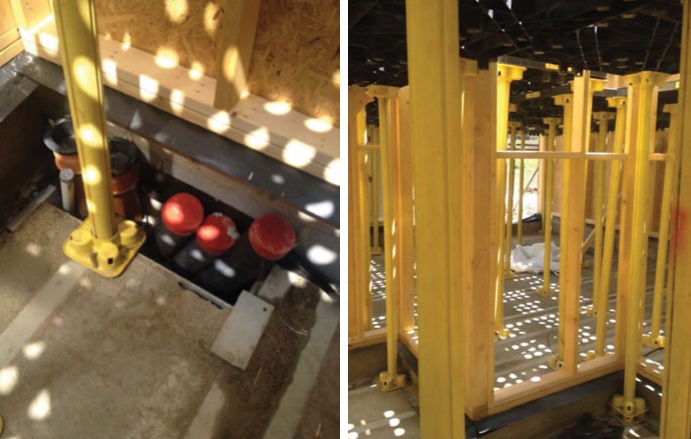The importance of soil analysis
Sunil Singh Seera received Highly Commended for the Student Award for Excellence in Architectural Technology (Report) 2017, for research and a report that demonstrated a clear link to a real life technical problem,
Soil analysis is an important element for frame construction in build-up. It is essential that the content and behaviour of the soil is studied in depth by the structural soil engineers. This may involve investigation with test pits and the depths of pile boring.
This study was based on a site in Oxfordshire where there was a significant ground settlement that exceeded the contractors expectations based on the soil report.
Reference to this project: a timber framed apartment block was made throughout the report. Soil analysis was insufficient which resulted in ground collapse and significant subsidence of the building. This research was investigating issues surrounding the critical role played by soil analysis, the major characteristics of soil, the differential movement of soil, its behaviour under varied load conditions; the impacts of moisture and wet soil and the considerations for designing framed structures. It is anticipated that the outcomes and lessons learnt from the case study would benefit, and its important role in determining appropriate and effective ground conditions.
The properties and structure of soil significantly influence the design and strength of any foundation and the supported super structure. It is by using such information that the load capacity and bearing pressures may be calculated by the design team and the ultimate decision on the loads that may comfortably be supported, determined (Poulos, 2004).
Otherwise, this is a danger that the building weight and stability will be compromised. A number of tests have been devised and recommended to determine the soil structure, (Ramachandran and Stonecypher, 2010). With these tests in mind, this research focused on the existing project where this critical, important step was not carried out to a satisfactory extent.
These were the driving objectives for this research work that were considered to be an influence on the main major design decisions:
- To understand the critical role played by soil analysis and ground survey.
- To understand and appreciate the major characteristics of soil types.
- To comprehend the differential movement of soil types and their behaviour under load.
- To investigate the impact of introduced moisture on soil and effects of wet soil on stability.
- To establish and appreciate the main considerations when designing support for framed structures.
A timber frame apartment block was a live site. During the foundation design, the significance of soil analysis was never fully appreciated. This consequently effected further ground settlement which was beyond the expected amount which in turn led to ground collapse. After a period of rain, the structure subsided in the right corner to an angle of ten degrees.
Considering that soil analysis had already been conducted, the reason for the collapse needed to be investigated. Either way it was down to poor soil analysis or insufficient design of the structure. This investigation and subsequent conclusion form the basis for this technical report, emphasising the need to appreciate the necessity of good accurate soil analysis prior to construction.
Judges’ comments:
A substantial piece of research that demonstrates a clear link to a real-life technical problem. Judges considered this work highly commendable as Sunil addressed the impact soil can have on the structural integrity of what is built atop — therefore underpinning any application of the technology of architecture. He demonstrated competence and understanding of the discipline with the chosen methodology and testing. The value of linking physical testing with theoretical background is highlighted in the work.
This article was originally published in the AT Autumn issue 123.
--CIAT
[edit] Related articles on Designing Buildings Wiki
Featured articles and news
Government consultations for the summer of 2025
A year of Labour, past and present consultations on the environment, the built environment, training and tax.
CMA competitiveness probe of major housing developers
100 million affordable housing contributions committed with further consultation published.
Homes England supports Greencore Homes
42 new build affordable sustainable homes in Oxfordshire.
Zero carbon social housing: unlocking brownfield potential
Seven ZEDpod strategies for brownfield housing success.
CIOB report; a blueprint for SDGs and the built environment
Pairing the Sustainable Development Goals with projects.
Types, tests, standards and fires relating to external cladding
Brief descriptions with an extensive list of fires for review.
Latest Build UK Building Safety Regime explainer published
Key elements in one short, now updated document.
UKGBC launch the UK Climate Resilience Roadmap
First guidance of its kind on direct climate impacts for the built environment and how it can adapt.
CLC Health, Safety and Wellbeing Strategy 2025
Launched by the Minister for Industry to look at fatalities on site, improving mental health and other issues.
One of the most impressive Victorian architects. Book review.
Common Assessment Standard now with building safety
New CAS update now includes mandatory building safety questions.
RTPI leader to become new CIOB Chief Executive Officer
Dr Victoria Hills MRTPI, FICE to take over after Caroline Gumble’s departure.
Social and affordable housing, a long term plan for delivery
The “Delivering a Decade of Renewal for Social and Affordable Housing” strategy sets out future path.
A change to adoptive architecture
Effects of global weather warming on architectural detailing, material choice and human interaction.
The proposed publicly owned and backed subsidiary of Homes England, to facilitate new homes.
How big is the problem and what can we do to mitigate the effects?
Overheating guidance and tools for building designers
A number of cool guides to help with the heat.
The UK's Modern Industrial Strategy: A 10 year plan
Previous consultation criticism, current key elements and general support with some persisting reservations.
Building Safety Regulator reforms
New roles, new staff and a new fast track service pave the way for a single construction regulator.


























